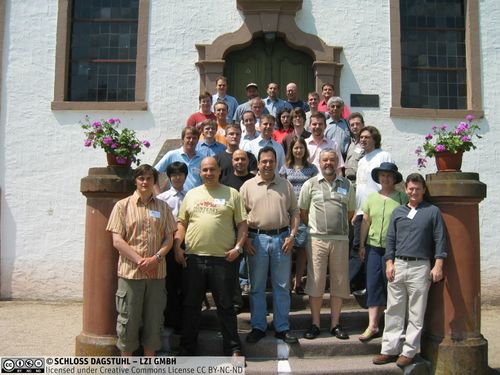Dagstuhl Seminar 06241
Human Motion – Understanding, Modeling, Capture and Animation. 13th Workshop on Theoretical Foundations of Computer Vision
( Jun 11 – Jun 16, 2006 )
Permalink
Organizers
- Reinhard Klette (University of Auckland, NZ)
- Dimitris Metaxas (Rutgers University - Piscataway, US)
- Bodo Rosenhahn (Leibniz Universität Hannover, DE)
Contact
Modeling, tracking and understanding of human motion based on video sequences is a field of research of increasing importance, with applications in sports sciences, medicine, biomechanics, animation (avatars), surveillance, and so forth. Progress in human motion analysis depends on research in computer graphics, computer vision and biomechanics. Though these fields of research are often treated separately, human motion analysis requires an interaction of computer graphics with computer vision, which also benefits from an understanding of biomechanic constraints. This seminar brought together specialists and students from these disciplines, studying and contributing to the subject of human motion analysis from different perspectives. The interdisciplinary character of the seminar allowed to bring people together which normally would not have met at disciplinary conferences.
Eadweard Muybridge (1830-1904) is known as the pioneer in motion capturing with his famous experiments in 1887 called ``Animal Locomotion'' (Do all feet leave the ground during the gallop of a horse? He used photography to answer the question.) The field of animal or human motion analysis has developed into many directions since then. However, human-like animation and recovery of motion is still far from being satisfactory. Various groups are dealing with different aspects of modeling, estimation and animation of human motions. Motivations differ, and define directions of research. Examples of motivations are the analysis of movements for disease detection (hip dislocations, knee injuries etc.), sports movement optimization (ski or high jumping, golf playing, swimming, etc.), the animation of avatars in movies (e.g. Gollum in Lord of the Rings), or the realistic character animation in computer games.
New results and specific research strategies have been discussed at this seminar to approach this highly complex field. The seminar intention was to discuss theoretical fundamentals related to those issues and to specify open problems and major directions of further development in the field of human motion related to computer vision, computer graphics or biomechanics. The seminar schedule was characterised by flexibility, working groups, and sufficient time for focused discussions. The participants of this seminar enjoyed the atmosphere and the services at Dagstuhl very much. The quality of this center is unique.
There will be an edited book (within Springer's series on Computational Imaging) following the seminar, and all seminar participants have been invited to contribute with chapters. The deadline for those submissions is in September 2006 (allowing to incorporate results or ideas stimulated by the seminar), and submissions will be reviewed (as normal). Expected publication date is the end of 2007 or early 2008.
- Stephan Al-Zubi (Universität Kiel, DE)
- Irene Albrecht (MPI für Informatik - Saarbrücken, DE)
- Harald Böhm (TU München, DE)
- Thomas Brox (TU Dresden, DE) [dblp]
- Stefan Carlsson (KTH Royal Institute of Technology, SE)
- Leo Dorst (University of Amsterdam, NL)
- Ahmed Elgammal (Rutgers University - Piscataway, US)
- Jürgen Gall (MPI für Informatik - Saarbrücken, DE) [dblp]
- Richard Green (University of Canterbury - Christchurch, NZ)
- Daniel Grest (Aalborg University Ballerup, DK)
- Atsushi Imiya (Chiba University, JP) [dblp]
- Yusuke Kameda (Chiba University, JP)
- Uwe Kersting (University of Auckland, NZ)
- Gisela Klette (University of Auckland, NZ) [dblp]
- Reinhard Klette (University of Auckland, NZ) [dblp]
- Volker Krüger (Copenhagen Inst. of Technology Aalborg University, DK)
- Dimitris Metaxas (Rutgers University - Piscataway, US) [dblp]
- Yoshihiko Mochizuki (Chiba University, JP)
- Meinard Müller (MPI für Informatik - Saarbrücken, DE) [dblp]
- Lars Mündermann (Stanford University, US)
- Michael Neff (MPI für Informatik - Saarbrücken, DE)
- Vladimir Pavlovic (Rutgers University - Piscataway, US)
- Tido Röder (Universität Bonn, DE)
- Dieter Rosenbaum (Universitätsklinikum Münster, DE)
- Bodo Rosenhahn (Leibniz Universität Hannover, DE) [dblp]
- Guy Rosman (Technion - Haifa, IL)
- Tomoya Sakai (Chiba University, JP)
- Dimitris Samaras (SUNY - Stony Brook, US)
- James Sherman (University of Maryland - College Park, US)
- Josephine Sullivan (KTH Royal Institute of Technology, SE)
- Tomas Svoboda (Czech Technical University, CZ)
- Matthias Teschner (Universität Freiburg, DE)
- Christian Theobalt (MPI für Informatik - Saarbrücken, DE) [dblp]
Related Seminars
- Dagstuhl Seminar 9411: Theoretical Foundations of Computer Vision (1994-03-14 - 1994-03-18) (Details)
- Dagstuhl Seminar 9612: Theoretical Foundations of Computer Vision (1996-03-18 - 1996-03-22) (Details)
- Dagstuhl Seminar 98111: Evaluation and Validation of Computer Vision Algorithms (1998-03-16 - 1998-03-20) (Details)
- Dagstuhl Seminar 00111: Multi-Image Search, Filtering, Reasoning and Visualisation (2000-03-12 - 2000-03-17) (Details)
- Dagstuhl Seminar 02151: Theoretical Foundations of Computer Vision -- Geometry, Morphology, and Computational Imaging (2002-04-07 - 2002-04-12) (Details)
- Dagstuhl Seminar 04251: Imaging Beyond the Pin-hole Camera. 12th Seminar on Theoretical Foundations of Computer Vision (2004-06-13 - 2004-06-18) (Details)
- Dagstuhl Seminar 08291: Statistical and Geometrical Approaches to Visual Motion Analysis. 14th Workshop “Theoretic Foundations of Computer Vision” (2008-07-13 - 2008-07-18) (Details)
- Dagstuhl Seminar 11261: Outdoor and Large-Scale Real-World Scene Analysis. 15th Workshop "Theoretic Foundations of Computer Vision" (2011-06-26 - 2011-07-01) (Details)
- Dagstuhl Seminar 15081: Holistic Scene Understanding (2015-02-15 - 2015-02-20) (Details)
Classification
- Computer graphics
- computer vision
- Biomechanics
Keywords
- Human motion
- object representation
- pose recovery
- inverse kinematics


